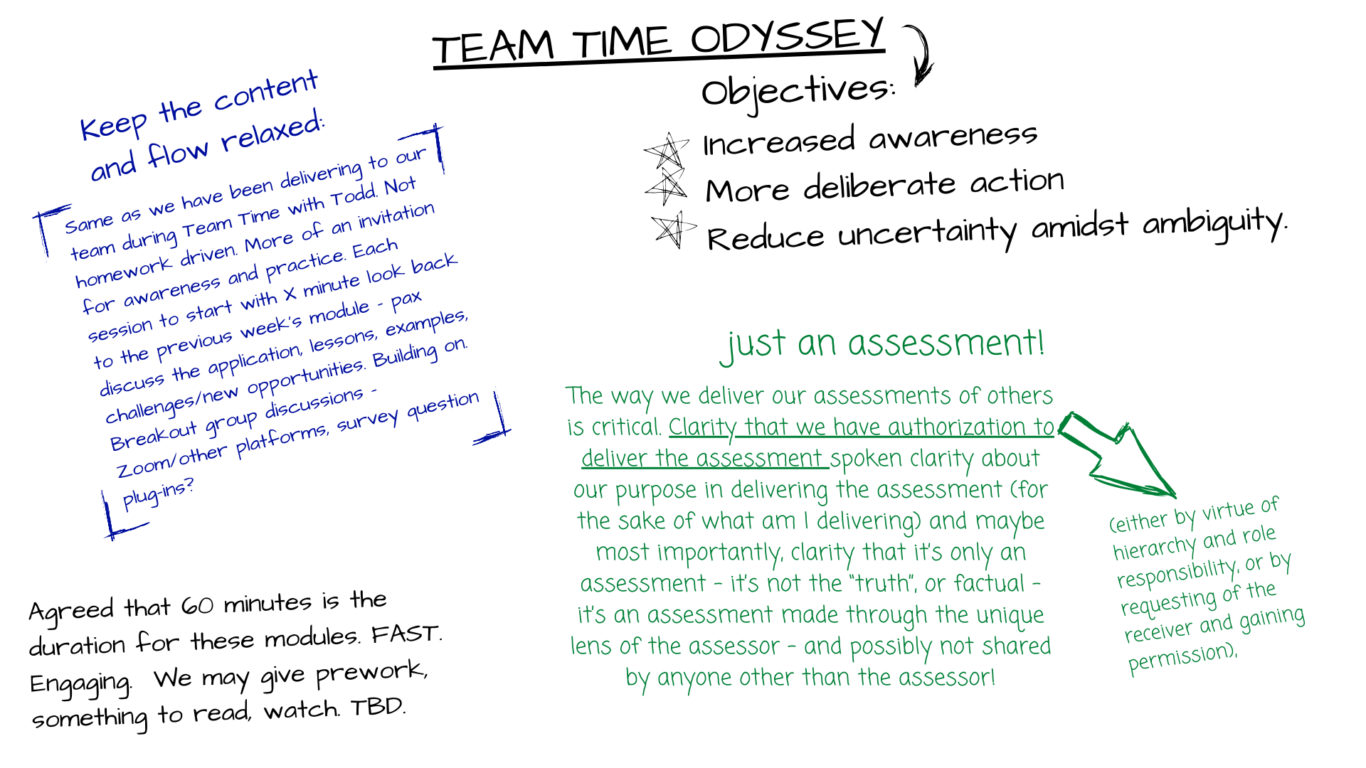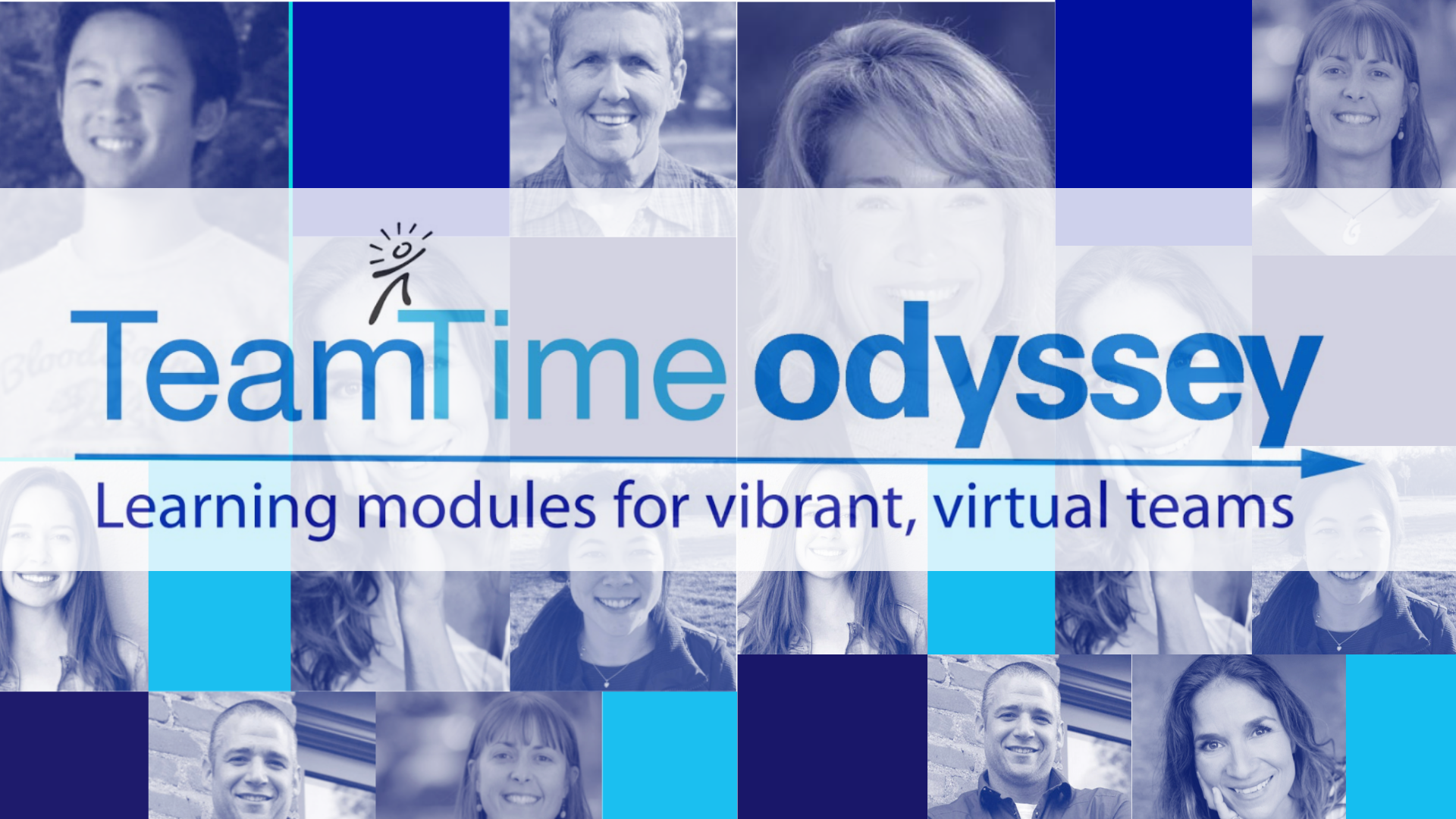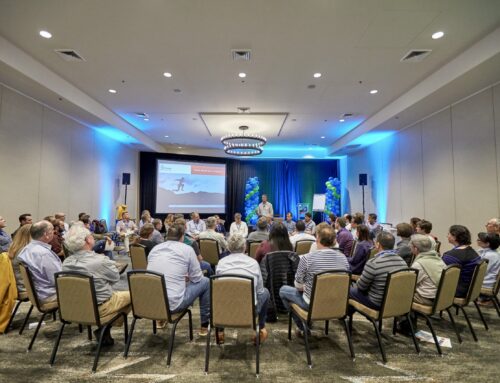Team Time Odyssey is a series of six, fast-paced, one-hour sessions to help build a more vibrant and virtual team; a more adaptive, aligned and ambitious team; a more resilient and ready team.
Have a look at the ‘napkin’ notes – a raw, unedited view of the design notes by three of Odyssey’s lead facilitators with a mere 75 years of experience. This should help answer who we are, where we are going (with your team) and why you can trust us.

Create common language, opportunity to express existing viewpoints/perspectives – current state, future state, new perspectives, new actions. Opportunities to improve morale, performance, teamwork, communication, resiliency.
Pax to leave each module with: That was valuable for me/us; it’s applicable to these areas of my/our work.
Yes. Each component will answer the question of ‘What does this (component/module) have to do with me, my/our team, my/our business’. In other words….What new practices will I do?
There are moves that help to remove ambiguity and leave less to chance.
Zexo.club – Selling SMTP 100% Inbox – SMTP for Spamming – Bulk Email Sender with SMTP unlimited emails per day – Spam Tools – Office 365 Full Spamming Setup – AWS SES Smtp Limit 50k day – Kagoya, Wadax Japan smtp – Sms Spamming – Bulletproof cPanels & Shells for scampage – Fresh Office 365 2fa cookies Link and Attachment – Craxs RAT – Fud Crypter – XWorm RAT
Contact :
Website : https://zexo.club/
Telegram Channel : https://t.me/zexoclub
Telegram : https://t.me/zex0club
How do we respond to Ambiguity?
Combo of Compulsory modules & Elective modules
Six weeks: Four compulsory, Two Elective. Further customization available upon request. Agreed that 60 minutes is the duration for these modules. FAST. Engaging. We may give prework, something to read, watch. TBD.
Many of the iconic Odyssey components of a live program can be woven:
- Five Whys
- Little Voices
- Crossed thumbs
- Clockwise – Perspective
- Performance Principles
- Accountability (vs Responsibility)
- Trust
- Difference between Problem and Breakdown
- Victimhood
- Commitment
- Giving and Receiving feedback
- Decision making model
- Moods – Mood quadrants – Julio
- Mindfulness=Chau Yoder
- Start-stop-continue
- The opposite of Like is not dislike, it’s disdain.
- Catch yourself being yourself
- Pre-Listening
- Ladders of Inference
- How to give acknowledgement
- Backup
- If you knew this about me, we would be a better team
- Action, promise Cycle – Requests, Offers, Promises, Commitment, Declaration of Satisfaction
- Dealing with Change/Ambiguity/Uncertainty.
- Something to think about, something to feel, something to do
Team Time Odyssey: Module Design
1)= setting the foundation, how to get the most value out of the program, ART,
Bene’s = foundation is established,increased connections and awareness re self & team.
Foundation – Early on I would introduce the barriers to learning (enemies of learning in some circles) … reveal them, and ask pairs to come up with their top three. Then .. accentuate at some point (if the pax don’t) that “I already know this” is going to show up! I have a simple “Distinction conversation,” it separates us as performers from the rest of the world – Intro of the coming topics (and other, based on what the client has selected) – loosen them up (Introviews style exercise, practice the use of ‘breakout rooms/conversations as a standard we will use for small conversations to facilitate broader team participation) – I’d add a simple place your feet flat on the floor and take three, slow deep breaths, centering practice of sorts, a bring yourself present to the meeting standard to be repeated (maybe expand the “body” as a module even, there are clients/teams up for this) – our opening pieces “prisoner” … To get the most … catch yourself, extend, want each other … basically the opening we do with clients in a standard program.
2)= words matter
Bene’s = A powerful way to view forks in the road. Distinctions re mood and how to shift to productive moods.
Words matter. And, this for me is a Language and Action conversation – there are universal “speech acts” – and understanding that there are only 5-6 shared by all languages (meaning everything you hear is one of these) is a really powerful set of distinctions relative to being a clear communicator and gaining clarity from others … Request, Offer, Promise (or commitment), Assessments, Declarations (basically assertions). Practice includes providing examples and having breakout teams, pairs? Decide which speech act the example is and why. Start easy and get harder. An example from a meeting, Maybe like with Allison yesterday …during our conversation about image orientation something like “we need to gather these thoughts into a coherent set of actions” – sounds like a simple statement ( but there are no “simple statements” in the speech acts), it is a weak (incomplete) request for action, built on an unspoken assessment that the thoughts are currently not in a coherent set of actions. Then, watch me pull a rabbit out of my hat … Allison reveals a set of coherent actions :)
2B) Moods and Action
As Todd might say – you can’t do much positive in a crappy mood …. But why am I in a crappy mood? I would insert the Moods and Action conversation here. And I believe it can be a stand alone, but has to be after Language distinctions. It basically addresses a matrix that clearly depicts the way humans react to things … and how our assessment at the moment not only shapes but reduces our various capacity for specific actions. This is a matrix that will enable participants to more easily become aware of the role that their assessments are having in their capacity to either take, or not take effective action.
3)= a new view, a diagnostic tool, and Honesty?)
Bene’s = A useful tool from examining where/how Trust may be breached and ways to raise trust levels.
Trust, where does it come from (earned, given, a privilege) – opening pairs conversation, In 30 seconds come up with as many answers that make sense and finish this sentence: “Trust is ________” Three domains of Trust – because the declaration (speech act) “I don’t trust her” is a broad brush that is open to interpretation by a listener. The exercise after creating the distinction of the 3 Domains of Trust is to provide the example and ask teams/pairs to chat about what these new distinctions offer them as leaders – provide the declaration – I don’t trust Susan” then ask the teams/pairs to view the declaration through the lens of “She isn’t competent in that domain,” or “she hasn’t been reliable given her current level of responsibilities,” or “she often says yes, when she has no intention of fulfilling (not common)” – ask the participants how this distinction can be applied in their roles as leaders and managers of people. Looking for things like – get her training, reduce or clarify her priorities, have a conversation about a serious issue of deception. As a leader this 3-Domain thing is a powerful distinction. The role of Honesty, then dovetails onto this really well.
4)= if not me, who? Responsibility is what?
This is the Accountability conversation to me. The distinction between accountability and responsibility is essential to the conversation. I can “assign responsibility” (it’s actually a request, because decline is an option – with consequences), but I can’t assign accountability (we use the words “Frank,you are accountable for the closing report on Friday,” but we are really making a request of Frank to be responsible for the report on Friday. Frank ultimately decides if he is going to be accountable for meeting the request. Clearly we are making a distinction for the sake of understanding the role of our commitment. Can then add the commitment conversation – is there anything less than 100% … is, “I’ll try” a commitment? The fun of taking the word “try out of our vocabulary” — commitment is best said by Yoda … No! Try not! Do or Do Not, there is no TRY!
5- MSU/Walk-By, triangulation
Bene’s = Allows for more empathy and understanding with others. Tool for examining situations. Intro to assessments
To me this is Assessments – one of the speech acts :) (or perspective). It’s a major component of the way I see things, all origination of action. Before I do anything I make a conscious, or not) assessment of the result/outcome. Almost everything is an assessment – can provide on the screen the text from a newspaper and have participants identify the number of assessments or assertions (facts). There are TONS of assessments stated as an assertion (fact) but very, very few data points. Add the value of “grounding an assessment” … it’s the evidence we have to support our assessments – it doesn’t make it a “truth”, but it builds a case for our assessment. Great tool for how to effectively deliver assessments (and yes, that’s an assessment stated like an assertion!)
6 – POV and mantra “I can see how…”, Start/Stop/Continue
Bene’s= Learn how to receive feedback in a useful, grounded way. Assessments continued.
Start/Stop/Continue (exercise for intro-practicing of delivery of assessments) Points … Feedback distinctions … generally understood as good/bad, positive/negative. Introduce the use of “generative assessment” – Ex. “For the sake of supporting your commitment to being an exciting facilitator I have an assessment for you – are you open to it?” … the standards of assessment delivery, by authority (manager has a responsibility to deliver), by request or offer (peer-to-peer, or upstream) — practicing the delivery of assessments (generally there is a “declaration” of gratitude, vs a “delivery” of gratitude.) – understanding these distinctions make us powerful communicators and open us to effectively being genuine with one another.
7- Gratitude and/or Listening
Bene’s = creating trust, affirming one contribution to the team, exploring different ways to listen (and for what). Todd shared listen model. Stand & Sit.
I would find a space for Listening (vs. hearing). This is where I would place the “pre-listening” as it lands well after the distinction of “assessment” has been worked on for a bit. There are some ways to practice this and could be done in pairs via breakout rooms.
8- Commitment Cycle, simple and often subtle though the identity of you and your team will excel when this is put into practice
Benes: shows where and how to close loop holes in efficiency,
Wow – lot’s to say on this. I’ll be brief. The Commitment Cycle is a fundamental practice that will reduce waste and cycle time, clarify responsibilities and generate aggressive prioritization. In my world this would be compulsory, but it needs to come after the core learning modules. The core modules are necessary for this conversation to be most effective. I would make it a really strong #5. “Beware, this is the section where the powerful learning barrier might rise up, I already know this” … provide a simple action/commitment cycle diagram. Show/Explain the cycle, ask where they “assess” (vs. where there “are”, which would be an assertion) current breakdowns in their world – personal and/or professional examples. Introduction of Open loops, which are unfinished Commitment Cycles that hang on us like a weight … and moves to close loops. These can be things I am committed to doing, or that others committed to delivering to me. Both cases are open loops. The answer to “overwhelm” is to close loops!
9) Dealing with Ambiguity (maybe also Change)
Frank: Ambiguity might be a lack of assessed clarity. I say assessed because the test is a request for information “is this situation ambiguous to everyone (universally)” – the answer tells us if it is an assessment (varying perspectives) or an assertion (all see it the same). I would refer back to the Mood Matrix conversation in this section, because after the core modules, conversations in the domain of change and ambiguity would be much richer, and easier to make sense of in my assessment. There are clear moves to shifting out of ambiguity. Assessment of change … from within the same organization … “I hate it here, nothing is set in stone, things are always changing, constantly shifting” … and … “I love it here, nothing is set in stone, things are always changing, constantly shifting” … there are underlying assessments of how change may impact me … what is the assessment, is it grounded, what other assessments could you have?
10) Maybe: The role of the body in action







Leave A Comment
You must be logged in to post a comment.